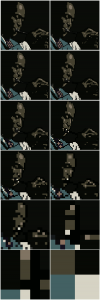Followup Friday
Part the First Readers of this page may recall a mention of Mia Wiesner and the survey she was conducting on the expectations readers have of digital comics. Ms Wiesner emailed me a few days ago with the preliminary results, which I will now summarize for you (please note, I am rounding most of the original numbers to the nearest percent):
- There were 441 completely-answered surveys
- 91% of respondents do (or would) read digital comics
- 45% have already purchased digital comics, 27% may do so, 19% never will
- The genres most likely to be read digitally are
- Science Fiction
- Humor/Comedy
- Fantasy
- Superhero
- Crime/Mystery
- The least-appealing aspects of digital comics are
- Not actually owning the comic
- DRM
- Lack of physicality
- File format incompatibility
- Need to repurchase if file gets damaged
Further results are pending release by the university, and we will bring them to you when available.
Part the Second It’s been many years now that this page has considered questions of What’s fair game for creators to reference?, with the earliest example I can find being this one. I actually was thinking back to that situation (Rich Stevens received a C&D for selling highly-abstracted pixel images inspired by Star Wars that LucasFilm objected to), because of something I read yesterday.
Back then I was asking myself, How few pixels does Rich have to use to represent a TIE Fighter or Stormtrooper helmet before it’s too abstract for Lucas to object?¹
The thing that I read yesterday that asks (essentially) the same question was a well-written bit on Fair Use by Andy Baio, regarding a pixel version of the cover of Miles Davis’s Kind of Blue. The image in question was commissioned by Baio to accompany a chiptune tribute to Kind of Blue; he’d cleared the musical rights, but hadn’t thought it necessary to do so for the cover. That decision cost him some US$32,500 when he found himself on the receiving end of a demand from lawyers representing the photographer of the original image.
Much like I interpreted Fair Use doctrine in the Steven/Lucas case, Baio felt he was probably in the right, but couldn’t afford the process of fighting it out in court. He’s not angry or bitter in his posting, but does end on a really good question that echoes mine from 2006: how few pixels, how low-res do you have to go before it’s Fair Use? Scroll down to the bottom of Baio’s posting and have a guess. One warning, though — there is no right answer².
_______________
¹ Or, since Lucas would always object, the more accurate question would be How few pixels for the abstraction to have separated the reference from the original, for the transformation to be so complete that Fair Use is undisputed even by a Hollywood lawyer?
² Yet. There will be someday, when somebody with enough money takes something to the Supreme Court and we get some precedent. By the way, we’re currently at nine days and counting.

Found the expectations of readers really interesting and useful. Thanks for breaking that down!
By Eben07 on 06.24.11 10:06 pm
[…] Preliminary Results on What People Look for in Digital Comics (In Brief) Original Source: Fleen […]
By Newscast for July 3rd, 2011 | The Webcast Beacon Network on 07.06.11 2:42 pm
[…] of Applied Sciences in Liepzig) conduct a study of purchasing attitudes for digital comic content. He’s posted initial findings and has a more in depth look at the implications of the numbers yesterday. Final statistic […]
By Digital comics study: Most readers won’t pay same price as printed version The Daily Cartoonist on 10.12.11 12:01 pm
[…] has confirmed to me that the results of her digital comics survey (announced here, initial results here, final results discussed last week) are available to anybody who wants them. There’s not a […]
By Fleen: Home Of The Webcomics Action News Team! » I Knew I Should Have Saved Something From NYCC on 10.19.11 12:03 pm
The above comments are owned by whoever posted them. The staff of Fleen are not responsible for them in any way.